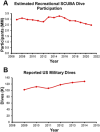Physiological monitoring to prevent diving disorders
- PMID: 39744705
- PMCID: PMC11688341
- DOI: 10.3389/fphys.2024.1517361
Physiological monitoring to prevent diving disorders
Abstract
Insight into human physiology is key to maintaining diver safety in underwater operational environments. Numerous hazardous physiological phenomena can occur during the descent, the time at depth, the ascent, and the hours after a dive that can have enduring consequences. While safety measures and strict adherence to dive protocols make these events uncommon, diving disorders still occur, often with insufficient understanding of the factors that triggered the event. This review first examines the most common diving disorders and their incidence rates across recreational and US military dive activities. The review then identifies physiological biomarkers (e.g., heart rate, heart rate variability, blood pressure, respiration rate, temperature, oxygen saturation) that may provide a holistic view of the diver's current physiological state and potentially detect the most concerning diving disorders (e.g., decompression illnesses, gas mixture-related disorders, barotraumas, and environment exposure). Although considerable research is still needed to verify the use of these biometrics in the diving environment, the research described in this review presents a promising path to developing a system that can detect pending diving disorders and provide divers and other necessary parties with an early warning before mishaps occur.
Keywords: biometric monitoring; diving disorders; diving mishap analysis; physiological metrics; wearable sensors.
Copyright © 2024 Beatty, Evans, Gravelyn, Tumperi, Daubon and Veith.
Conflict of interest statement
The authors declare that the research was conducted in the absence of any commercial or financial relationships that could be construed as a potential conflict of interest.
Figures



Similar articles
-
A review of nutritional recommendations for scuba divers.J Int Soc Sports Nutr. 2024 Dec;21(1):2402386. doi: 10.1080/15502783.2024.2402386. Epub 2024 Sep 24. J Int Soc Sports Nutr. 2024. PMID: 39314069 Free PMC article. Review.
-
Risk mitigation in divers with persistent (patent) foramen ovale.Diving Hyperb Med. 2019 Jun 30;49(2):77-78. doi: 10.28920/dhm49.2.77-78. Diving Hyperb Med. 2019. PMID: 31177512 Free PMC article.
-
Persistent (patent) foramen ovale (PFO): implications for safe diving.Diving Hyperb Med. 2015 Jun;45(2):73-4. Diving Hyperb Med. 2015. PMID: 26165526
-
On diver thermal status and susceptibility to decompression sickness.Diving Hyperb Med. 2015 Sep;45(3):208. Diving Hyperb Med. 2015. PMID: 26415073
-
Recreational scuba diving, patent foramen ovale and their associated risks.Swiss Med Wkly. 2001 Jun 30;131(25-26):365-74. doi: 10.4414/smw.2001.09706. Swiss Med Wkly. 2001. PMID: 11524902 Review.
References
-
- Acott C. (1999). A brief history of diving and decompression illness. SPUMS J. 29 (98–109), 31.
-
- Aguilella-Arzo M., Alcaraz A., Aguilella V. M. (2003). Heat loss and hypothermia in free diving: estimation of survival time under water. Am. J. Phys. 71 (4), 333–337. 10.1119/1.1531581 - DOI
-
- Ajčević M., Buoite Stella A., Furlanis G., Caruso P., Naccarato M., Accardo A., et al. (2022). A Novel non-Invasive thermometer for continuous core body temperature: comparison with tympanic temperature in an acute stroke clinical setting. Sensors 22 (13), 4760. 10.3390/s22134760 - DOI - PMC - PubMed
Publication types
LinkOut - more resources
Full Text Sources

